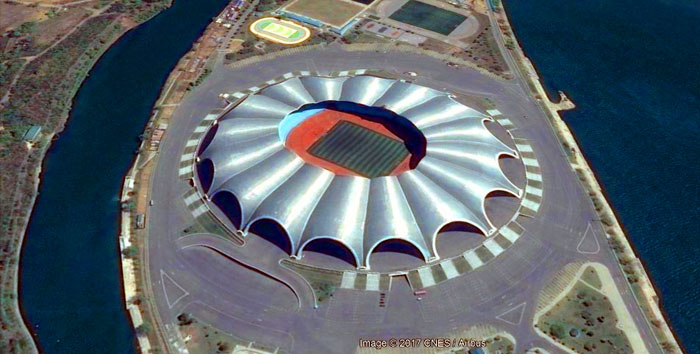Huge sporting stadiums may be a thing of the past, with stadium design now focusing on spectator experiences and comfort, and the move to TV and online viewing. However, nothing beats being part of a sell-out crowd of fans watching their teams battle it out on the field, and there will always be a place for watching live sporting events.
We have listed only the classic enclosed stadiums, not including horse and car racing venues such as Indianapolis Motor Speedway which can be expanded to cater to up to 400,000 spectators. Also worthy of note is Strahov Stadium in Prague, Czechia, a stadium which is no longer used for competitive sports events (just large concerts!). It has a capacity of 220,000 (56,000 seated).
This list of largest stadium capacity is very different from the list of largest stadium attendance for sporting events. Most of the high attendance figures are from the past when there was a large component of standing room.
The Top-10 Largest Sports Stadiums
These listed capacities were from figures published in August 2022 and are subject to change.
| Stadium | location | capacity | |
|---|---|---|---|
| 1 | Narendra Modi Stadium | Ahmedabad, Gujarat, India | 132,000 |
| 2 | Rungrado May Day Stadium | Pyongyang, North Korea | 114,000 |
| 3 | Michigan Stadium | Ann Arbor, Michigan, USA | 107,601 |
| 4 | Beaver Stadium | State College, Pennsylvania, USA | 106,572 |
| 5 | Ohio Stadium | Columbus, Ohio, USA | 102,780 |
| 6 | Kyle Field | College Station, Texas, USA | 102,733 |
| 7 | Tiger Stadium | Baton Rouge, LA, USA | 102,321 |
| 8 | Neyland Stadium | Knoxville, Tennessee, USA | 101,915 |
| 9 | Darrell K. Royal-Texas Memorial Stadium | Austin, Texas, USA | 100,119 |
| 10 | Bryant–Denny Stadium | Tuscaloosa, Alabama, USA | 100,077 |
 View of Rungrado 1st of May Stadium located in Pyongyang, North Korea, the world's 2nd largest stadium
View of Rungrado 1st of May Stadium located in Pyongyang, North Korea, the world's 2nd largest stadium Notes on Capacity
Stadium capacity is listed as actual seats where a spectator can buy a ticket for a sporting event. This does not include press box seats, standing room, and added chair capacity. Some stadiums are able to modify the seat arrangements depending on the event. One such stadium is the Cowboys (AT&T) Stadium in Arlington Texas, which is listed as having a seating capacity of 80,000, but apparently it is expandable to 105,000 with standing room.
Sometimes the attendance at the stadiums can be greater than the listed capacity. For example: The highest attendance at the Darrell K. Royal-Texas Memorial Stadium was recorded at 102,315 at Texas' season opener against Notre Dame in 2016, despite the listed capacity of 100,119. See largest sporting crowds.
Other large sporting venues (but not stadiums)
The list of largest stadiums is for classic enclosed stadiums and does not include horse and car racing venues. A large sporting venue that is in use (but is not a stadium) is Circuit de la Sarthe, the site of the 24 Hours of Le Mans motor race in France. It has a capacity of 263,500. Other large race tracks are also not included, such as the Indianapolis Motor Speedway which has a capacity of 257,325. Another large venue is the Tokyo Racecourse with a capacity of 223,000 (with seating for 13,750).
Related Pages
- The Top-10 largest sporting stadiums in the USA
- List of largest stadium sporting event attendance
- List of Stadium Wonders of the World
- World's Largest Sporting Crowds
- All Sporting Stadiums
- Stadium Designs of the Future
Old Comments
Commenting is closed on this page, though you can read some previous comments below which may answer some of your questions.
- It would be interesting to see how many of these stadiums have benches. The Melbourne Cricket Ground used to be 2nd on this list. However it has individual seating (not benches) and standing room is limited. If it was configured in the same manner as American football stadiums on this list, it would be closer to 200,000 seated (mainly because cricket requires a much large playing area). I think for this reason it would be good to list actual seated capacities and whether they are bench or non bench. The bench capacity for MCG alone is 120,000 (exclude standing). from Glenn Stewart (2020)
- Stadium capacity is listed as actual seats where a viewer can buy a ticket, with one sporting event. This does not include press box seats, standing room, and added chair capacity. Just because a stadium has 279,000 people in it, doesn't mean it is it intended capacity. Likewise, venues and complexes may have high capacities, but it is not limited to a single exhibition. from G J (2016)
- D.I.S. is the largest sports stadium in the world, it should be number one. from Scotty Moir (2016)
- Strahov stadium in Prague - 250 000 capacity. The stadium can hold eight football fields, from Filip sochurek (2016)
- Yes, it is big, but my understanding is that it is no longer used for competitive sports events. Rob Admin filip sochurek (2016)
- It's massive. It cannot be on the list, because it's not used for current events. Worth noting as well, although the size cannot be matched (and it's unlikely it ever will), the seating capacity is around the rim and hold 45,000. This is less than half every stadium on this list in terms of seated capacity. Every stadium here inflates numbers including some standing. But some of them need standing area. The Melbourne Cricket Ground for example is a cricket stadium. Cricket always has some standing but it only account for under 5% of capacity. Furthermore, old stadiums such as this used to have a much higher seated capacity because they used to have benches. During the Melbourne Olympics, a baseball game was held in the MCG as a demonstration (to see if baseball could be included in the Olympics). Due to bench seating as standing capacity, the crowd was estimated to be 114,000 which held the professional baseball crowd record until the past few years. Glenn Stewart filip sochurek (2020)
- Dallas Cowboys stadium holds 101,000 people which goes in 8th My name jeff (2016)
- The AT&T Stadium (as the Dallas Cowboys stadium is called) has a seating capacity of 80,000, but apparently expandable to 105,000 with standing room. It is not clear if this 105k capacity is as used for sporting events (as this list is about sporting stadiums), as it may be just for concerts or other events. ..then, according to capacity, it would be 5th (Rob Admin - 2016)
- Indianapolis Motor Speedway has a capacity of 235,000, but can be expanded with infield seating up to 400,000. Dayne (2016)
- The Indianapolis motor speedway is much larger. Leslie Bird (2016)
- This is false the MCG is larger than royal texas. Theo Bighead (2016)
- Not based on current listed capacities. Do you have data to back up your claim? Seating capacity of stadiums do change over time with changes in seating configurations and renovations. The maximum attendance of the G is about 130,000 from 1959 but there was a lot of standing room in those times. Rob Admin (2016)
-
This is false. Michigan stadium is larger than Braver Stadium. Steven Caulford (2015)
- Thanks for that, I have updated much of the list. There has been a lot of changes in the last couple of years. (mod)
- Bush park in Treowen has a 279 000 capacity you can fit the whole of Luxembourg inside. Joe (2016) - Where is that stadium? I can't find any reference to it online, maybe it has another name (ed)
- Rome's Circus Maximus in ancient times SEATED 250,000+. When i found out about this it blew my mind comparing it with modern structures. Raz Cann joe (2020)
- Wow, the stadiums are huge. But I never new Melbourne is so big. Jake, Nov 2020.



